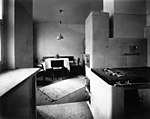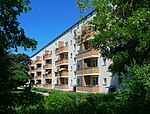Reichsforschungssiedlung Haselhorst

The Reichsforschungssiedlung Haselhorst is a residential complex in the Haselhorst district of Berlin . It was built between 1930 and 1935 and is the result of a 1928 competition organized by the Reich Research Association for Economic Efficiency in Building and Housing to build a model estate for over 10,000 people. After the RFG was dissolved in June 1931, the Foundation for the Promotion of Building Research, as its legal successor , took over the financial support for the construction work.
The aim of the project was to research the profitability of different apartment floor plans, construction processes and construction techniques. The architects Walter Gropius and Stephan Fischer won the competition with a consistent linear construction concept. However, the ten to twelve-story high-rises favored by Gropius were not built, but predominantly four-story rows of houses. The non-profit Heimstätten AG Groß-Berlin (Heimag, later: Gewobag ) , commissioned with the construction, awarded the design planning for individual construction phases to Fred Forbát , Otto Bartning , Paul Emmerich and Paul Mebes , as well as other architects.
Most of the 3500 apartments built were one- and two-room apartments with an area of 40 to 50 m². This was to cover the need for inexpensive small apartments for working-class families in the nearby industrial settlements (such as Siemens in Siemensstadt and Borsigwerke in Tegel ).
The settlement has been a listed building since 1995 . From 2003 to 2013, the residential complex was modernized by Gewobag for 130 million euros in accordance with listed buildings, whereby some apartments were enlarged by merging.
A museum apartment in the estate has been open to the public since 2014. It has been restored in accordance with the listed building standards and is furnished in the style of the early 1930s.
Staircase in Burscheider Weg 6e
Block of Fred Forbát , garden Straße 134
With Birch limited way residential lines at Burscheider way
Nazi memorial stone from 1935, Lüdenscheider Weg / Haselhorster Damm
Eagle's nest with clutch by Max Esser , 1936
literature
- Spandau-Haselhorst research settlement. Competition of the Reich Research Society for Economic Efficiency in Building and Housing V. In: Zeitschrift für Bauwesen . Vol. 79, 1929, No. 4, pp. 79–110 ( digital.zlb.de ).
- W .: The Reichsforschungssiedlung in Spandau. In: The new Berlin. Monthly booklet for problems in the big city. Jg. 1, 1929, No. 2, ZDB -ID 748487-2 , pp. 31-32.
- Franz Seeck: To the competition of the Reich Research Society. In: Urban planning . Vol. 24, 1929, pp. 89-92 ( digitized version ).
- R. Heiligenthal: The competition for preliminary designs for the Haselhorst research settlement. In: Urban planning. Vol. 24, 1929, pp. 92-96 ( digitized version ).
- Martin Wörner, Doris Mollenschott, Karl-Heinz Hüter: Architectural Guide Berlin. 6., revised. and exp. Edition. With an introduction by Wolfgang Schächen . Red. Paul Sigel. Dietrich Reimer Verlag, Berlin 2001, ISBN 3-496-01211-0 .
- Henry Alex: Haselhorst. The history of the Berlin-Spandau district at the foot of the citadel (= research on the history of the city and fortress Spandau. Volume 2). Local history association Spandau 1954 e. V., Berlin 2010, ISBN 978-3938648-02-5 .
- Michael Bienert: Modern architecture in Haselhorst. History, residents and restoration of the Reichsforschungssiedlung in Berlin-Spandau. 1st edition of the revised. and exp. New edition. Edited by Gewobag Wohnungsbau-Aktiengesellschaft Berlin. Berlin-Story-Verlag, Berlin 2015, ISBN 978-3-95723-050-8 .
Web links
- The Reichsforschungssiedlung. In: gewobag.de
- The museum apartment. In: gewobag.de
- Entry in the Berlin State Monument List . In: stadtentwicklung.berlin.de
Individual evidence
- ^ Rainer W. During: A new look at yesterday's future. In: Der Tagesspiegel . June 9, 2007, accessed March 2, 2019.
- ↑ Uwe Rada : Small kitchen, great demands. In: The daily newspaper . November 20, 2013, accessed March 1, 2019.
- ^ The museum apartment in Haselhorst. In: gewobag.de, accessed June 27, 2019.
Coordinates: 52 ° 32 ′ 40 ″ N , 13 ° 14 ′ 18 ″ E










